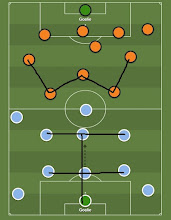In memory of Diogo Jota, his rapid rise in the early career with Paços de Ferreira undeniably
proved how his talent truly was.
The departure of Diogo Jota recently has undoubtedly shocked the football
world. The Portuguese international was still at the peak of his career when he
lost his life in a car accident with his brother, Andre Silva, a Penafiel man.
The Liverpool forward was still 28 years old and had just tied the knot with
his long-time girlfriend and the mother of his three children.
To pay tribute to the former Wolves frontman, the beginning of his career
with the modest Portuguese side, Pacos de Ferreira, deserved more spotlight
apart from his golden years with The Reds. It was where the world began to see
the quick rise of the Massarelos-born striker on the pitch in his teens.
He joined Pacos at the age of 16 after his talent was spotted by the team’s
scouts when he was still 13 years old. At that time he was still playing for
the local side, Gondomar SC.
2014/15 Season
Diogo Jota made his debut with the first team in Portuguese La Liga on
February 20th, 2015, in the home fixture against Vitoria Guimares on match 22.
The game ended in a 2-2 tie, and he was only fielded for seven minutes.
Previously, he only played for the team in the Portuguese Cup. In September
2014 against Atletico Reguengos in the third round, he made an instant impact by netting one and providing one assist in a 4-0 win, at the age of 17.
The versatile forward quickly became the first choice as he played in ten
more games, nine in the league and one match in Taca de Portugal during the
2014/15 season. His first contribution in the top flight was on matchday 25
against Boavista. Jota set up the only goal of the game on their home turf,
scored by the skipper, Manuel Jose.
His first goals in the top division came in May 2015 as he bagged a brace
when his team thumped Academica Coimbra 3-2. In his season debut, Jota managed
to score four goals and four assists in all competitions. However, his team,
which was under the tutelage of the current Lyon boss, Paulo Fonseca, was only
able to finish sixth at the end of the campaign.
2015/16 Season
In his second season, he already sealed his spot in the team and contributed
more. The former forward, who was also into E-Sports, made 35 appearances in
all competitions; 31 of them were in the league. He registered 14 goals and 10
assists under Jorge Simao following Paulo Fonseca’s departure to Sporting
Braga.
Jota’s most notable games were the home matches versus FC Porto and Sporting
Braga. He did not only score a goal but a winning goal for both games. Paços de
Ferreira snatched crucial 1-0 victories in both fixtures. Such results helped
them sit in sixth place again in the final standings. Jota also netted a brace
in a 2-2 draw against CS Maritimo to salvage the team from defeat in front of
their own fans.
Atletico Madrid, a move that never happened
His impressive form in the 2015/16 campaign apparently caught the attention
of Diego Simeone’s Atletico Madrid. Los Cholconeros signed the 20-year-old frontman for 7 million euros in the summer of 2016, although the announcement
was already released in March.
However, the Argentine boss did not seem to be ready to integrate the
ex-Portuguese international with 49 caps into his team. Thus, Jota was loaned
out twice to FC Porto and Wolverhampton Wanderers. His spell with the
Portuguese giant was fine with nine goals and seven assists in 2016/17, but
such failed to bring silverware. Porto only finished as the runner-up in the
league.
Jota’s fine form led him to join Wolves with its Portuguese connection in
the team. He continued his top form and even signed for Wolves permanently in
summer 2018, meaning that he never played for Los Rojiblancos in a single game.
The versatile forward then helped Nuno Santo’s men to gain promotion as well as
qualify for Europe before moving to Anfield. The rest is history.


Comments
Post a Comment